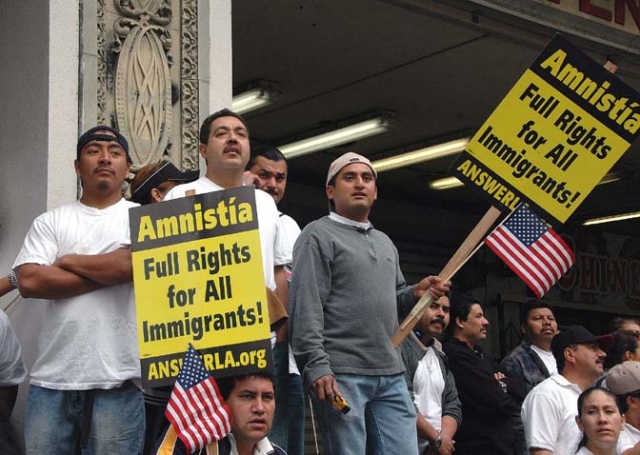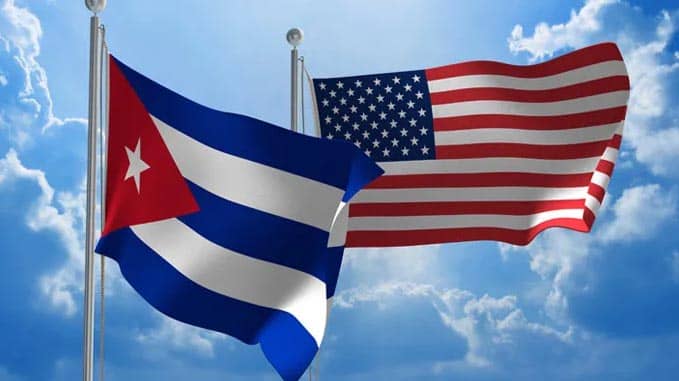Migration, Trump, Biden and What is to Come

Photo: Bill Hackwell
In addressing the immigration issue in the United States, two errors are commonly made: one is to consider that the country rejects immigration flows on a permanent basis and, second, to consider that one federal party or another is pro- or anti-migrant.
The United States was formed as a country from an influx of immigrants that subjugated and dispossessed the native population of its original territories. The current growth of its economy would come to a screeching halt if such an influx were stopped. The fundamental executive action on this issue is to try to regulate the flows and make them predictable, so that they can be accompanied by both federal funds and the budgets of private companies, allowing for an orderly assimilation by society.
A Cato Institute document recently characterized the contradiction faced by the United States in dealing with the immigration issue, stating that the U.S. economy was expanding, which in itself generates a demand for unskilled labor, but at the same time does not find legal ways to enter the country.
For this reason, migrants arriving mainly from nearby Caribbean, Central and South American countries would have no practical option but to try to cross the border illegally, with the help of well-established human smuggling networks.
To the reasons mentioned by the Cato Institute should be added the push factors that are present in the countries of origin, such as underdevelopment, corruption and the effect of unilateral coercive measures as in the cases of Venezuela and Cuba.
Until 2016, the immigration debate between Democratic and Republican politicians was more related to what treatment should be given to undocumented immigrants already residing in the United States, rather than to regulating the magnitude of the human mass transiting without visas or identity documents across land or maritime borders.
The purpose of the so-called immigration reform proposed by the Democrats was to regularize the legal status of some 12 million people living in the country, but without documents proving their status as residents or citizens. The ultimate goal was that a good part of that total would go so far as to obtain citizenship, so that, in gratitude, they would exercise their right to vote in favor of their Democratic “saviors”.
Had they succeeded in that regard, the Democrats would have turned around the voting totals in several states and at the federal level, which the Republicans would have taken many years to swing. Trying to win the backing of Congress and key Republican leaders for his reform, the Obama administration pursued a heavy-handed policy at the border and carried ou deportations of undocumented immigrants in record numbers, earning him the moniker of Deporter-in-Chief.
These actions were executed, however, amidst contradictions that presupposed specific programs directed against certain countries that pursued very well calculated destabilization objectives.
For their part, the Republicans, who held a majority in the U.S. House and Senate during the last quarter of the Obama administration, repeatedly imagined partial solutions to the problem, also with an electoral objective, but which often pitted federal leaders against the interests of specific states. They did not manage to articulate any program that would benefit them in terms of the number of votes in their favor, at the expense of the immigration regularization of a human group, but they did work intensively with the political leadership of various migrant communities, with the objective of mobilizing them at election time.
In short, until 2016 the main U.S. political forces reasoned the immigration equation in terms of procedural favors in exchange for votes. It was then that the third vision of a businessman turned top executive appeared.
Donald Trump was a candidate who capitalized on the feelings of frustration of the economic sectors that were harmed by free trade policies, especially the so-called “old economy”, which includes everything from fossil fuel exploitation to agriculture and construction.
Trump and his team never aspired to court immigrant groups or other minorities. They gathered behind their agenda an approximate 30 to 33% of the immigrant electoral roll, which was enough by itself to place their representative in the White House.
For Donald Trump the essence of the immigration debate was not in terms of votes, but how to exponentially reduce the value of the unskilled immigrant labor force. For this reason, he unleashed hateful language against this population group, he raved about the idea of a fortified wall on the border with Mexico, and he maintained a high rate of deportations. As a consequence, the unskilled immigrant abandoned social activism, accepted the same job for less pay and lived in constant fear. But under that cloak of a top-down attitude against a “threat”, the flow of scientists, professors, doctors, computer scientists and other specialists continued to flow into the U.S. to meet the demands of high-tech industries and other institutions in the most advanced sector of the economy.
Since the results of the 2020 elections, the accession of Joe Biden to power and the return to the Democratic proposals prior to 2016, a group of unconnected initiatives on the immigration issue were generated, none of which attacked the root causes of this disorderly human movement. On the contrary, those actions in their parallel development increased and did not diminish the migratory flows through the southern border.
The case of Cuba
One of the last memorandums of understanding signed in the administration of Barack Obama and the Cuban government in January 2017 was precisely on the migration issue, which summarized in a certain way the experience of previous similar initiatives (1984, 1994, 1995) and other specific measures. The implementation of the package of decisions that the agreement contained was the main reason why during 2018 there was close to zero undocumented emigration from Cuba to the United States.
This agreement was reached and began to be implemented in a context in which regular commercial flights between the two countries were put into effect and expanded, the flow of cruise ships was stabilized and a group of people-to-people exchange actions took place that favored and did not impede a predictable, orderly and safe human movement.
But the panorama changed dramatically, first with the closing of the U.S. consular office in Havana, the failure of the United States to comply with its obligations under the immigration agreements, and finally with the abrupt halt to the movement of aircraft and ships between the two countries. To this was added a string of economic asphyxiating measures against the island, which brought its population to an existential limit when combined with the effects of the COVID19 pandemic.
As a result, it is estimated that half a million Cubans left their country of origin by legal means or left other places of temporary residence (Europe, Latin America) between 2021 and 2023 and accessed the U.S.-Mexico border with the help of local coyotes and smugglers. Upon arrival at the border posts, their Guatemalan, Honduran and other companions were mostly rejected, but the Cubans were admitted under the presumption of “credible fear” of the consequences of being returned to their country.
This is a really high number, but it is made relative when compared to the number of Cubans who traveled annually to the U.S. for temporary visits before the Trump shutdown.
In addition to the fact that citizens of Cuban origin continue to enjoy certain privileges before the rest of the potential migrants, thanks to the provisions of the so-called Cuban Adjustment Act of November 2, 1966, other realities weighed for such “preferential” treatment.
The United States is a country with a deficit of professionals in areas such as health (deficit of 124,000 doctors in the next 10 years), education (51,000 teachers left their posts only in 2023 and 86% of schools have incomplete staff), information technology and communications (the sector demands 750,000 professionals in cybersecurity alone). These are precisely areas of knowledge in which Cuba prepares specialists who stand out from the regional average and who access the U.S. market through illegal immigrant channels and who, therefore, are willing to accept jobs for lower pay than professionals coming from other latitudes.
The post-2024 scenario
In the run-up to the November 2024 presidential election, a new dynamic has emerged that could determine how the issue is handled by any government that is elected in that election. State authorities in the territories bordering Mexico, particularly those in Texas, have begun to take a leading role in confronting undocumented immigration that approaches an attitude of contempt for federal authorities.
The fact of spreading undocumented newcomers to several states, by air and land, and assuming the responsibility of border control to the detriment of the capabilities of federal agencies, adds a new contradiction to an already complex situation.
The governor of Texas’s proactive attitude received the support of 25 other Republican counterparts, in contrast to a supposed agreement negotiated by both parties in the federal Senate. The fact has been used by the still candidate Donald Trump to further oxygenate the support of his bases in the South of the United States and to mark the ground before an equivocal and incoherent Joe Biden.
Those politicians represent areas of the country with unequal demand for imported labor and unequal times, rhythms and costs of assimilation of newcomers into their social fabrics.
These contradictions will not disappear with the passage of the presidential election. Whatever the outcome, the United States will maintain discriminatory practices in the face of undocumented immigration, criminalizing those with lower qualifications and economic opportunities, while encouraging the entry of highly skilled specialists in key sectors of its economy through federal programs.
It is to be expected that in a practical way, even without modifying laws and regulations, existing privileges with respect to specific groups of migrants by nationality, which have been determined only for foreign policy reasons, will be eliminated.
In the case of Cuba, it is to be expected that there will be a combination of several dynamics in which selective brain drain, the increased return of undocumented migrants, differential treatment with respect to representatives of new productive and intellectual forms, and the encouragement of illegal departures that are later aborted with the consequent frustration of their commissioners will be intertwined.
For any future negotiations that may take place between the two countries on this matter, it should be recalled time and again that this has been an issue that has been regulated in the bilateral dispute only on the basis of the political will of both parties. Cuba has shown this will on a permanent basis; in the case of the United States, its attitude has been conditioned by particular ambitions that do not necessarily serve the national interest of that country.
First published on https://resumen-english.org/2024/02/migration-trump-biden-and-what-is-to-come/#more-25803



Déjanos tu comentario